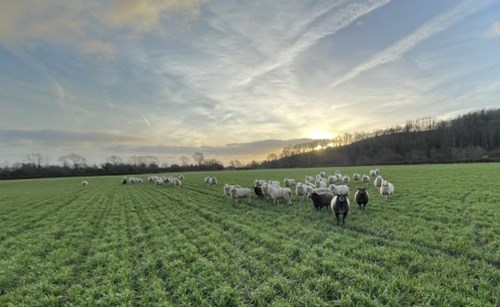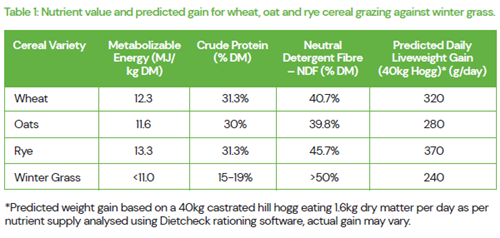The “Golden Hoof” – Sheep Grazing Winter Crop

Grazing winter cereal crops - otherwise known as the golden hoof - is a method where sheep graze down cereal crops usually between November and early March for short periods of time during tillering (growth stage (GS) 21-29) but not after stem extension (GS 30).
From a livestock and mixed farming perspective, winter cereals can provide a useful source of feed at a time of year when feed is naturally in short supply and gives grazing pastures an often much-needed rest.
This practice offers many benefits to the cereal crop, including helping to reduce fungicide usage, promoting tillering and crop health through lambs eating away dead leaf and also contributing some additional nitrogen through manure. As well as benefits to the crop, there are advantages for the sheep in that the crop offers a cheap feed source over the winter with good nutrition when there is limited grass, and the grazing is clean with no worm burden. In addition, grazing your sheep on winter crops allows grass pastures to rest during a period of low growth.

An early harvest this year, has allowed for early establishment of winter cereals, with reports of winter cereals such as oats and wheat being sown at least two to three weeks ahead of usual in some areas. Winter barley, wheat and oats can be grazed, barley will tend to be more forward than wheat and oats so should be grazed first. Early maturing varieties are ideal for this system, provided they are not stressed, if this is the case do not graze them. Also, crop must have a strong root system to avoid them being pulled out of the ground. Some crops will be more tolerant than others and will cope with harder grazing, so it is important to seek advice and to closely monitor stock. With crops being sown earlier combined with milder autumns/winters there is a risk cereals going into the winter will be overgrown, this increases the crops susceptibility to frost damage. By grazing the cereal down this will reduce its risk to potential frost damage. Also, importantly this year, where there are concerns over forage availability and low silage yields. Grazing the winter cereals offers a higher protein feed source reducing the reliance on already stretched silage stocks while contributing to improved grassland management; by resting the grazing it allows for some recovery for either late winter or early spring grazing.
It is important to manage and monitor how the crop is grazed to avoid damage to the crop. Ideally lambs are grazed at a high stocking rate on the cereal crops for a short period of time, usually between 3-14 days, this will allow the crop to be evenly grazed. Make use of short grazing periods with high stocking densities, moving across fields quickly suits this method of grazing. Grazing the leaf to ground level is the aim. However, caution must be taken not to overgraze as this will slow the crops recovery and have a potential yield loss. The practice must also not be carried out with saturated ground, poaching of the cereal will lead to damage so ideally the crop should have close run back to grass or be set up that the stock can be moved off quickly if need be.
SAC Consulting’s Ruminant Nutritionist Lorna Shaw undertook a small-scale study into the performance benefits of lambs grazing winter cereals in winter 2024/2025. The study was funded by the Mains of Loirston Trust and involved two flocks grazing cereal crops over winter assessing crop nutrient value, estimating dry matter intakes and assessing lamb performance by monitoring average weight of lambs before cereal grazing and again on exit to determine estimated average daily liveweight gain.
The cereal crops to be grazed as part of her study were all sampled shortly before lambs were due to graze to determine nutrient value of the crop and also mineral supply. A dry matter prediction was also carried out on the same day using a 0.5m² quadrat to measure fresh weight per ha with Wheat, Oat and Rye crops sampled throughout the trial.
Table 1 below shows the average nutrient value and predicted daily liveweight gain (DLG) of a 40kg hill hogg for the three winter sown cereals analysed compared to average back end grass grazing.

The initial analysis assuming predicted dry matter intake requirements are met in full demonstrates that winter cereal grazing has the potential to provide an elevated plane of nutrition for hoggs over winter compared to typical grazing platforms. The rye crop at sampled showed the highest nutrient value of all crops sampled. Wheat was the next highest although it must be noted there was large variation between fields sampled due to differing establishment practices with ME ranging in wheat samples between 10.7 – 13.2 ME. The oat crop energy was impacted by frost during late December and early January with a high level of dead leaf at sampling.
Grazing winter cereals is not a new practice, it is a tried and tested method, offering benefits for both shepherd and cereal producer.
5 Key Take Home Messages
- What to graze - Winter barley, wheat and oats can be grazed. Start with grazing the most forward crops.
- When to graze – Ensure the crop is established and graze while it is tillering (growth stage 21-29) and not into stem extension (growth stage 30), at which point there is a risk of reducing the yield through damage to the ear.
- How to graze - Graze over a short period of time e.g., 3-14 days with a high stocking rate.
- How to manage - It is important to monitor the grazing and be able to move sheep quickly if needed. Have a back-up plan in case of bad weather.
- The ‘golden hoof’ provides an opportunity to work alongside neighbouring sheep farmers to improve collaboration and or allow new entrants the opportunity for winter grazing with low capital costs.
Jamie Houston, Consultant, Jamie.Houston@sac.co.uk

Unearthed is the exclusive SAC Consulting members' monthly newsletter. Unearthed offers insights and tips from our experts on what we think is in store for farming and crofting in the coming months in order to protect and enhance your business.
Posted by Unearthed News on 14/10/2025
